|
Richard and Ruth Levin Duree
|
|
CLICK AN IMAGE FOR LARGER VIEW
Richard "Rich" Duree, who found folk dancing in Sacramento, California, in December, 1960, actually became "hooked" the following March. He was new to Sacramento, having just gone to work for the Department of Justice, and a colleague invited him to go to a dance concert on Sunday afternoon at the Memorial Auditorium. They were late, and the first thing he saw when they entered was a performance of the Ukrainian Hopak. It took his breath away, because he knew that these were not professional dancers and that he could do that, too!
He'd been active in martial arts for many years and was very interested in human movement. That and the music made him an instant convert. He joined the Dionysian Dancers and performed with them for a couple of years, then joined Bruce Mitchell's Camtia Folk Ensemble and danced with them for several years. He also studied with Wee Steuber, who still was one of the best teachers he ever worked with, because she instilled in him a sense of value in folk dance.
In the late 1960s, he decided that he needed a career change and was serious about dance by then. He enrolled in the Dance Program at San Francisco State University with Anatol Joukowsky and studied with him for two years, receiving his BA degree in Dance in 1969. Three years later, he enrolled in the graduate program in dance at Cal State University, Fullerton, and taught four undergraduate courses in folk dance there. After receiving his MA in Dance Ethnology, he taught dance and physical education as an Adjunct Associate Professor (for over 20 years).
 Richard became very interested in learning theory and began to develop teaching skills by borrowing techniques from the many superb teachers he had encountered over the years. He came across an article by Dr. Hugh Thurston of the University of British Columbia in which his discussion on "choreogeography" changed his view of folk dance from that of simple recreation to an in-depth examination of the relationships between ethnic dance and the cultures that created them. The burning question became, "Why do people dance the way they do?" That question led him to some very interesting places.
Richard became very interested in learning theory and began to develop teaching skills by borrowing techniques from the many superb teachers he had encountered over the years. He came across an article by Dr. Hugh Thurston of the University of British Columbia in which his discussion on "choreogeography" changed his view of folk dance from that of simple recreation to an in-depth examination of the relationships between ethnic dance and the cultures that created them. The burning question became, "Why do people dance the way they do?" That question led him to some very interesting places.
He became an internationally known dance ethnologist, offering international dance classes in Appalachian Clog, Balkan, Ballroom, Czech, Early Californian, German, Hungarian, Old West, Ragtime, and Victorian dance. He also has expertise in Beginning Instruction, Dance Ethnology and History, Dance Pedagogy, and Teacher Training.
Richard was the founder, artistic director, and business manager of the Dunaj International Dance Ensemble, Inc. based in Orange County, California, which he organized in 1976. Dunaj's repertoire included suites of Appalachian, Austrian, Bavarian, Czech, Early Californian, Hungarian, and Ragtime dances. Richard was noted for his realistic choreographic portrayals of traditional village dance. He performed with Polskie Iskry Polish Dance Ensemble (Costa Mesa, Calif.), the Russian Folk Dance Group (San Francisco, Calif.), the Camtia Bayerische Schuhplattlers (Sacramento, Calif.), and the Dionysian Folk Ensemble (Sacramento, Calif.).
 Richard was active in the activities of the Folk Dance Federation of California (South), including chairperson of their Teacher Training Committee (1975, 1993, 2004). In addition to folk and ethnic dance, Richard's other academic activities and interests included dance ethnology and history, folk arts, dance theater, dance technique, holistic approach to dance, fitness and health, multicultural education, instructional design, and curriculum development. He taught fencing, bowling, outdoor recreation, fitness and aerobics, weight training, self-defense, firearms safety, personal defense, regional geography of Europe and North America, cultural geography, physical geography, and travel geography. He also had knowledge of grant writing, fund raising, public relations, media relations, and video production.
Richard was active in the activities of the Folk Dance Federation of California (South), including chairperson of their Teacher Training Committee (1975, 1993, 2004). In addition to folk and ethnic dance, Richard's other academic activities and interests included dance ethnology and history, folk arts, dance theater, dance technique, holistic approach to dance, fitness and health, multicultural education, instructional design, and curriculum development. He taught fencing, bowling, outdoor recreation, fitness and aerobics, weight training, self-defense, firearms safety, personal defense, regional geography of Europe and North America, cultural geography, physical geography, and travel geography. He also had knowledge of grant writing, fund raising, public relations, media relations, and video production.
Growing up on a Texas cattle ranch with a cowboy granddad, Richard was taught from a young age about cattle, horses, branding, and the general mind set of the American cowboy. He retained his historical interest in the Old West. So, in his spare time, he was an active member of the Single Action Shooting Society (SASS). Much like folk dancers who wear international costume, SASS members dress up in period clothing, carry and shoot firearms of the period 1865 to 1900, such as real .45s, lever action rifles, and side-by-side shotguns, at knock-down metal targets. Members are encouraged to take on aliases and many do much research into one that is not only suitable, but who has a "rich" history. Rich, for instance, was "Colonel Richard I. Dodge," of the United States Cavalry (Ret.). (Colonel Dodge led numerous military mapping expeditions into the Black Hills and throughout the west and had his journals published, which are a major source of information for historians, anthropologists, and others, including Richard himself.)
In 1983, Richard teamed with Dick Oakes on a Folk Dance Cruise on the S.S. Azure Seas which, however, never sailed! Richard also teamed up with Diki Shields for a Holiday Camp reunion in the mountains near San Bernardino, California.
 With a dance background in physical education, theater, history and anthropology, Richard and his lovely wife and dancing partner, Ruth Levin Dureé imparted an in-depth knowledge of dance technique and an appreciation of dance history to their teaching.
With a dance background in physical education, theater, history and anthropology, Richard and his lovely wife and dancing partner, Ruth Levin Dureé imparted an in-depth knowledge of dance technique and an appreciation of dance history to their teaching.
He studied with master dance ethnologists and historians in Europe and America, including Sándor Timár, Erno Pesovar, Zoltán Farkas, Zoltán Zsuráfszki (Hungarian), František Bonuš, Radek Rejšek, Vladimir Urban, and Irwin Vargas (Chech-Slovakian), Teodor Vasilescu, Alexandru David, Mihai David, and Eugenia Popescu-Judetz (Romanian), Bill Pillich and Richard Powers (Ballroom), Ada Dziewanowska, Christine Chiuk, and Morley Leyton (Polish), and Morry Gelman (German). He has also studied ethnology and folklore with such figures as Richard Crum, John Filcich, Elsie Dunin, and Otto Sadowszky.
Richard led several educational tours to Europe and toured the former Yugoslavia, Hungary, and the Czech and Slovak Republics. He produced full-length dance and music concerts throughout Southern California. In addition, Richard was Instructor of American Folk Dance at a dance seminar in Luhacovice, Moravia, and Instructor of European / American Folk Dance at the Pan Asian International Dance Camp in Taipei, Taiwan. In 1967, Richard conducted a four-month research project on Bavarian and Tyrolean dance, music, and folklore in Munich and Garmisch, Bavaria.
Among the professsional affiliations Richard has are the American Alliance for Health, Physical Education, Recreation and Dance (AAHPERD); Society of Dance History Scholars; Dance Critics Association; and Congress on Research in Dance. Richard also was the Southwest Representative for the National Folk Organization (NFO).
Among the awards Richard received was the Disneyland Community Service Award for Cultural Arts (1987). He received scholarships from both the Folk Dance Federation of California (North) and the Folk Dance Federation of California, South, to attend summer dance camps.
Ruth passed away on July 1, 2019 and Richard passed away on October 20, 2020.
A prolific writer, Richard was a freelance business writer specializing in instructional design and business writing for seven years. He also was the Dance Writer / Critic for three years for the Orange Coast Daily Pilot in Costa Mesa, California. Richard wrote dozens and dozens of articles for Folk Dance Scene, the news magazine of the Federation (South). Among his writings are
- "Choreogeography Series." Examines the historical, geographical, and cultural factors that influence the form and style of the dance. Includes:
- "Choreogeography - American Ragtime to Swing"
- "Choreogeography - American Vintage"
- "Choreogeography - Balkan Adriatic Coast"
- "Choreogeography - Bavarian Schuhplattler"
- "Choreogeography - Bulgaria"
- "Choreogeography - Croatia"
- "Choreogeography - Czech Republic and Slovakia"
- "Choreogeography - Germany"
- "Choreogeography - Greece"
- "Choreogeography - Hungary"
- "Choreogeography - Poland"
- "Choreogeography - Romania"
- "Choreogeography - Scandinavia"
- "Choreogeography - Spain"
- "Choreogeography - Transylvania"
- "Choreogeography - Turkey"
- "Choreogeography - Yugoslavia"
- "Choreogeography - Choreogeography - What is it?"
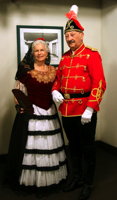
- "Allure of the Tango." What gives the tango this allure, this exotic promise?
- "The Art and Science of Dance Etnnology." An examination of the academic areas involved.
- "Csárdás." Discussion of the cáardás' history and evolution, with examination of older and newer forms, figures, concepts, techniques, and character.
- "The Contra Dance." It is a dance form that has lasted for half a millennium.
- "The Contradanza." The ranchos of Early California are a storied time in California's history.
- "Costumes of Montenegro." The man's long coat, either white or a pale green, and the women's surcoat create a long vertical silhouette.
- "The Cowboy Waltz." Just as in normal walking, you have to be a little off-balance to dance any spinning dance.
- "Dance in the Gold Rush." Discussion of the dance in California's mining camps.
- "Dance in the Old West." Discussion of the dance of Americans in the Old West and the influence of the military, migration, foreign immigrants, and social situations.
- "The Early California Fandango." Description of the dances, fandangos, costumes, music, and traditions of California in the Rancho Period before the Gold Rush.
- "Dances of the Victorian Old West." The European-Americans who moved into the Indian Territory -- and created what we now call "the Old West" -- danced, too.
- "Dance Tip Series." Discussion of various dance techniques for couple and chain dance, including partnering, leading / following, improvising, posture / balance, and linear and circular movements.
- "Dance Traditions - The Newsletter of Traditional Dance and Music." Choreographic studies, feature articles on events and artists, calendar of events, editorials, ethnic food, folklore, folk art, dance technique, and etiquette (1994 to 1999).
- "Enrich Your Dance." As students of the dance, we should be concerned with four different elements of the dance: its ethnology, its technique, its music, and its choreography -- in that order.
- "Folk Dance: A Window on the World of Learning." National Dance Association Conference Proceedings; "Dance as Learning" Conference.
- "Greeting the Newcomer." Suggestios for ensuring a successful and enjoyable experience to the casual "walk-in" observer to a folk dance session. Discusses the discomfort and embarrassment of being involved in dances with unfamiliar and confusing figures and the need for a pro-active program to teach learnable dances that the "walk-in" can learn quickly without the embarrassment of being singled out.
- "The History of Ragtime Dance." With thousands of composers creating the new Ragtime music everywhere, it quickly followed that someone would dance to it.
- "The Many Facets of Folk/Etnnic Dance." Folk/Etnnic dance has created and inspired an appreciation for artistic and cultural concerns in a way few activities can.
- "Motif Analysis in Ethnic Dance Research." Examination of the movement motifs unique to each ethnic group. Relates the motifs and movement character to the physical and social environment.
- "'Real' vs. 'Choreographed' Folk Dances." The cussin' and discussin' of "real" versus "choreographed" dances has gone on for as long as I've been folk dancing.
- "Romania's Căluşarii." The căluşarii are supernatural beings, removed from their normal lives as farmers or tradesmen.
- "Source Book." Discussion of teaching and learning methodology, physics and dance movement, partnering, anatomy and dance movement, and rhythm analysis for dance teachers.
- "Travel in Safety." Discussion of precautions and techniques to be followed to avoid criminal activity in foreign or strange environments. Focus is on increased awareness of potential dangers and pro-active movements to avoid or escape potential hazards.
- "What is Folk/Ethnic Dance." "Ethnic dance" is any dance form which can be identified as originating with an ethnic culture and expressing the movement aesthetics of that culture.
- "Why Do People Dance the Way They Do?" An examination of the environmental factors that influence the character of the dance in a non-industrial society; relates the factors of topography, climate, livlihood, clothing, footwear, and foreign occupation.
Dances Richard taught include Bačko kolo, Bunjevačko kolo, Forgatós, Furiant, and Tandrček.
CLICK AN IMAGE TO ENLARGE
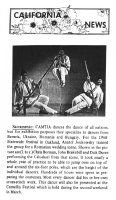 Camtia, 1968 |
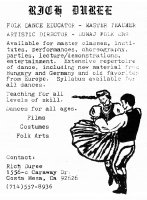 1979 |
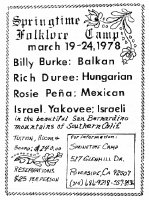 1978 |
 1983 |
 1985 |
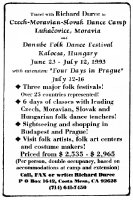 1993 |
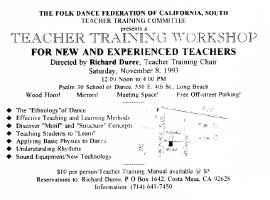 1993 |
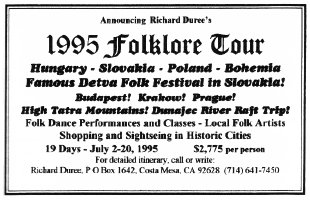 1995 |
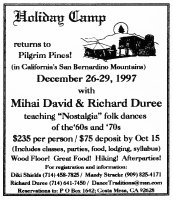 1997 |
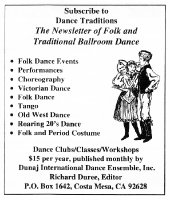 1999 |
 2004 |
